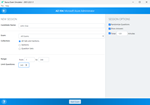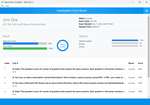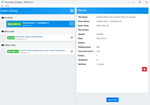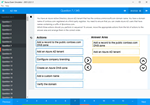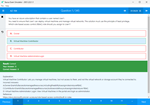Download Oracle Exadata X5 Administration.1z0-070.PassIt4Sure.2017-12-01.90q.tqb
| Vendor: | Oracle |
| Exam Code: | 1z0-070 |
| Exam Name: | Oracle Exadata X5 Administration |
| Date: | Dec 01, 2017 |
| File Size: | 2 MB |
How to open TQB files?
Files with TQB (Taurus Question Bank) extension can be opened by Taurus Exam Studio.
Purchase
Coupon: TAURUSSIM_20OFF
Discount: 20%
Demo Questions
Question 1
Batch and DSS workloads on your Exadata X6 Database Machine are causing performance problems for OLTP workloads at certain times of the day.
There are five RAC databases performing OLTP I/O. Two of them also perform batch I/O. There is another RAC database that performs only DSS I/O.
You are asked to resolve this problem so that the OLTP workload will not suffer when competing with the batch or DSS workloads.
You decide to use the I/O resource manager.
Which is the best way to solve this problem?
- Create a category plan with EXADCLI calling EXACLI to give the OLTP category the highest priority on all the cells, and use the Database Resource Manager to create the OLTP category and map all OLTP- oriented consumer groups in all databases to it.
- Use the Database Resource Manager to give the OLTP category the highest priority and use EXADCLI calling EXACLI to create the OLTP category on all the cells.
- Create a category plan with EXADCLI calling EXACLI to give the OLTP category the highest priority on all the cells, and use the Database Resource Manager to give the OLTP consumer group the highest priority on all databases.
- Create a database plan using EXADCLI calling EXACLI to give OLTP I/O the highest priority from all six databases.
Correct answer: C
Explanation:
You can manage I/O resources based on categories by creating a category plan. You can add any number of categories, or modify the predefined categories. You should map consumer groups to the appropriate category for all databases that use the same cell storage. Any consumer group without an explicitly specified category defaults to the OTHER category. References: http://docs.oracle.com/cd/E80920_01/SAGUG/exadata-storage-server-iorm.htm You can manage I/O resources based on categories by creating a category plan.
You can add any number of categories, or modify the predefined categories. You should map consumer groups to the appropriate category for all databases that use the same cell storage. Any consumer group without an explicitly specified category defaults to the OTHER category.
References: http://docs.oracle.com/cd/E80920_01/SAGUG/exadata-storage-server-iorm.htm
Question 2
Identify three valid reasons for creating multiple griddisks on a single harddisk-based celldisk.
- to implement storage realms so that storage that can be reserved for specific resource consumer groups in the same database
- to enable the creation of normal or high redundancy ASM diskgroups
- to segregate storage into multiple pools with different performance characteristics
- to enable disk mirroring for the system area
- to implement storage realms so that storage can be reserved for specific databases
- to implement storage realms so that storage that can be reserved for specific Grid Infrastructure
Correct answer: BCF
Explanation:
Creating multiple grid disks per cell disk allows you to create multiple pools of storage on the same Exadata Storage Server. The multiple grid disks can be assigned to separate ASM diskgroups, which can be provisioned to different databases. Note: Griddisk is a logical disk that can be created on a celldisk. In a standard Exadata deployment we create griddisks on hard disk based celldisks only. While it is possible to create griddisks on flashdisks, this is not a standard practice.F: After you complete the cell configuration, you can perform the following optional steps on the storage cell:Add the storage cell to the Exadata Cell realm Configure security on the Oracle Exadata Storage Server grid disks References: https://docs.oracle.com/cd/E80920_01/SAGUG/SAGUG.pdf Creating multiple grid disks per cell disk allows you to create multiple pools of storage on the same Exadata Storage Server. The multiple grid disks can be assigned to separate ASM diskgroups, which can be provisioned to different databases.
Note: Griddisk is a logical disk that can be created on a celldisk. In a standard Exadata deployment we create griddisks on hard disk based celldisks only. While it is possible to create griddisks on flashdisks, this is not a standard practice.
F: After you complete the cell configuration, you can perform the following optional steps on the storage cell:
- Add the storage cell to the Exadata Cell realm
- Configure security on the Oracle Exadata Storage Server grid disks
References: https://docs.oracle.com/cd/E80920_01/SAGUG/SAGUG.pdf
Question 3
Which three statements are true concerning the configuration of SNMP on an Exadata x5 or x6 Database Machine?
- All SNMP notifications from the storage server ILOMs are sent directly to the Automatic Service Request (ASR) manager.
- Some SNMP notifications may be configured using the alter cell command on the storage servers.
- The Database Machine internal Cisco Switch communicates directly with the Enterprise Manager agent via SNMP.
- Some SNMP notifications from a storage server ILOM are sent directly to the management server (MS) process on the same storage servers.
- All SNMP notifications from a database server ILOM are sent directly to the Automatic Service Request (ASR) manager.
- All SNMP notifications from a database server ILOM are sent directly to the management server (MS) process on the same database server.
Correct answer: BDE
Explanation:
B: You can configure SNMP Trap Destinations for the Exadata Storage Servers with the following command:# cellcli -e “alter cell snmpSubscriber=(host ='ASR-Manager-name-or-IP-address',port=162,community=public,type=asr)” D: Exadata Storage Server plug-inThis extends the monitoring of exadata cells in addition to providing a GUI interface. The plug-in uses an SSH connection to the cellmonitor user on the cells and uses list commands only. This is for interactive monitoring. One may also set thresholds using the plug-in which are distinct from any thresholds set using cellcli utility as the celladmin user. For alerts to be sent to the plug-in, SNMP traps are used as follows:Cell ILOM alerts are sent to the cell Management Server (MS) via an SNMP trap. The MS then send SNMP notifications onward to the plug-in. Cell alerts flagged by MS itself, such as cell thresholds being exceeded, or ADR software alerts, are sent to the plug-in using SNMP. E: Database Server ILOM plug-inMonitoring databases and their instances, ASM environments, the Grid Infrastructure, and the host software environment are done by Enterprise Manager in the usual way as these are standard targets. But monitoring the hardware for the database servers requires the ILOM plug-in, as there is no Management Server (MS) on the database servers to receive SNMP traps from the ILOM. The plug-in will receive sensor state and availability data from the ILOM including alerts based on pre-set ILOM thresholds. References:https://dbatrain.wordpress.com/2011/06/http://docs.oracle.com/cd/E21659_01/html/E21660/z40015671004046509.html B: You can configure SNMP Trap Destinations for the Exadata Storage Servers with the following command:
# cellcli -e “alter cell snmpSubscriber=(host ='ASR-Manager-name-or-IP-address',port=162,community=public,type=asr)”
D: Exadata Storage Server plug-in
This extends the monitoring of exadata cells in addition to providing a GUI interface. The plug-in uses an SSH connection to the cellmonitor user on the cells and uses list commands only. This is for interactive monitoring. One may also set thresholds using the plug-in which are distinct from any thresholds set using cellcli utility as the celladmin user. For alerts to be sent to the plug-in, SNMP traps are used as follows:
Cell ILOM alerts are sent to the cell Management Server (MS) via an SNMP trap. The MS then send SNMP notifications onward to the plug-in.
Cell alerts flagged by MS itself, such as cell thresholds being exceeded, or ADR software alerts, are sent to the plug-in using SNMP.
E: Database Server ILOM plug-in
Monitoring databases and their instances, ASM environments, the Grid Infrastructure, and the host software environment are done by Enterprise Manager in the usual way as these are standard targets. But monitoring the hardware for the database servers requires the ILOM plug-in, as there is no Management Server (MS) on the database servers to receive SNMP traps from the ILOM. The plug-in will receive sensor state and availability data from the ILOM including alerts based on pre-set ILOM thresholds.
References:
https://dbatrain.wordpress.com/2011/06/
http://docs.oracle.com/cd/E21659_01/html/E21660/z40015671004046509.html
Question 4
You have partitioned an X5-2 full rack into two four-node RAC clusters called CLUSA and CLUSB.
No virtualization is used and the storage grid has not been partitioned.
Which two set of files on which servers must be modified after connecting an Exadata storage expansion rack to your X5-2 Exadata Database Machine on the InfiniBand network so that the storage servers in the expansion rack are added to the storage grid?
- the CELLINIT.ORA files on the database servers in CLUSA
- the CELLIP.ORA files on the database servers in CLUSA
- the CELLINIT.ORA files on the database servers in CLUSB
- the CELLIP.ORA files on all existing Exadata storage servers
- the CELLIP.ORA files on the database servers in CLUSB
- the CELLIP.ORA files on all newly added Exadata storage servers
Correct answer: BE
Explanation:
The cellip.ora is the configuration file, on every compute node (database server), that tells ASM instances which cells are available to this cluster. The cellip.ora file contains the storage cell IP addresses. References: http://docs.oracle.com/cd/E80920_01/SAGUG/exadata-storage-server-configuring.htm#SAGUG20369 The cellip.ora is the configuration file, on every compute node (database server), that tells ASM instances which cells are available to this cluster.
The cellip.ora file contains the storage cell IP addresses.
References: http://docs.oracle.com/cd/E80920_01/SAGUG/exadata-storage-server-configuring.htm#SAGUG20369
Question 5
You plan to monitor the status of the motherboard, memory, power, fans, and network cards on the database nodes in your Exadata X6 Database Machine using Enterprise Manager.
Where must you set the thresholds for these hardware components and why, to assure that sensor readings, faults, and any related alerts, are visible in Enterprise Manager?
- No thresholds need to be set because they are present in the ILOM and in Enterprise Manager.
- Set thresholds in ILOM and in Enterprise Manager because they are not present anywhere and must be set in both places.
- Set thresholds only in ILOM because they are not preset anywhere but need to be set only in ILOM.
- No thresholds need to be set because they are preset in the ILOM and these are sufficient for monitoring.
Correct answer: D
Question 6
Examine this list of software components:
- Oracle Virtual Machine (OVM)
- Oracle Enterprise Manager Agent (OMA)
- ASM instance
- RDBMS instance
- Automatic Diagnostic Repository Command Interpreter (ADRCI)
- CELLCLI
- Cell Server (CELLSRV)
- diskmon
Identify the location where these software components can run in the standard Exadata Database Machine deployment.
- 1, 2, 3 and 4 run on the database servers; 5, 6, 7, and 8 run on the Exadata storage servers.
- 1, 2, 3, 4, 5, and 8 run on the database servers; 5, 6, and 7 run on the Exadata storage servers.
- 1, 2, 3, 4 and 8 run on the database servers; 5, 6, and 7 run on the Exadata storage servers.
- 3, 4 and 8 run on the database servers; 1, 2, 5, 6 and 7 run on the Exadata storage servers.
- 2, 3, 4 and 8 run on the database servers; 1, 5, 6 and 7 run on the Exadata storage servers.
Correct answer: B
Explanation:
Automatic Diagnostic Repository Command Interpreter (ADRCI) can be used on an Exadata storage server. Incorrect Answers:A: The diskmon process is a fundamental component of Oracle Exadata Storage Server Software, and is responsible for implementing I/O fencing. The process is located on the database server host computer, and is part of Oracle Clusterware Cluster Ready Services (Oracle Clusterware CRS).D, E: Oracle Virtual Machine (OVM) runs on the database servers. Automatic Diagnostic Repository Command Interpreter (ADRCI) can be used on an Exadata storage server.
Incorrect Answers:
A: The diskmon process is a fundamental component of Oracle Exadata Storage Server Software, and is responsible for implementing I/O fencing. The process is located on the database server host computer, and is part of Oracle Clusterware Cluster Ready Services (Oracle Clusterware CRS).
D, E: Oracle Virtual Machine (OVM) runs on the database servers.
Question 7
Which two statements are true regarding the use of Auto Service Request (ASR) with an X6 Database Machine?
- The database server ILOMs must use SMTP over the management network for notifications to ASR Manager.
- The database server ILOMs must have SNMP traps configured to use the management network for notifications to ASR Manager.
- The storage server ILOMs must have SNMP traps configured to use the management network for notifications to ASR Manager.
- The database server MS process must have SNMP traps configured to use the management network for notifications to ASR Manager.
Correct answer: BC
Explanation:
B: Database Server ILOM plug-inMonitoring databases and their instances, ASM environments, the Grid Infrastructure, and the host software environment are done by Enterprise Manager in the usual way as these are standard targets. But monitoring the hardware for the database servers requires the ILOM plug-in, as there is no Management Server (MS) on the database servers to receive SNMP traps from the ILOM. The plug-in will receive sensor state and availability data from the ILOM including alerts based on pre-set ILOM thresholds. C: Exadata Storage Server plug-in extends the monitoring of exadata cells in addition to providing a GUI interface. The plug-in uses an SSH connection to the cellmonitor user on the cells and uses list commands only. This is for interactive monitoring. One may also set thresholds using the plug-in which are distinct from any thresholds set using cellcli utility as the celladmin user. For alerts to be sent to the plug-in, SNMP traps are used as follows:Cell ILOM alerts are sent to the cell Management Server (MS) via an SNMP trap. The MS then send SNMP notifications onward to the plug-in. Cell alerts flagged by MS itself, such as cell thresholds being exceeded, or ADR software alerts, are sent to the plug-in using SNMP. References:https://dbatrain.wordpress.com/2011/06/http://docs.oracle.com/cd/E21659_01/html/E21660/z40015671004046509.html B: Database Server ILOM plug-in
Monitoring databases and their instances, ASM environments, the Grid Infrastructure, and the host software environment are done by Enterprise Manager in the usual way as these are standard targets. But monitoring the hardware for the database servers requires the ILOM plug-in, as there is no Management Server (MS) on the database servers to receive SNMP traps from the ILOM. The plug-in will receive sensor state and availability data from the ILOM including alerts based on pre-set ILOM thresholds.
C: Exadata Storage Server plug-in extends the monitoring of exadata cells in addition to providing a GUI interface. The plug-in uses an SSH connection to the cellmonitor user on the cells and uses list commands only. This is for interactive monitoring. One may also set thresholds using the plug-in which are distinct from any thresholds set using cellcli utility as the celladmin user. For alerts to be sent to the plug-in, SNMP traps are used as follows:
Cell ILOM alerts are sent to the cell Management Server (MS) via an SNMP trap. The MS then send SNMP notifications onward to the plug-in.
Cell alerts flagged by MS itself, such as cell thresholds being exceeded, or ADR software alerts, are sent to the plug-in using SNMP.
References:
https://dbatrain.wordpress.com/2011/06/
http://docs.oracle.com/cd/E21659_01/html/E21660/z40015671004046509.html
Question 8
Which three statements are true regarding the configuration of Auto Service Request (ASR) on an X5 Database Machine?
- ASR Manager may be installed on any type of server running Oracle Solaris.
- ASR Manager may be installed on any type server running Oracle Linux.
- Oracle Linux must be used on the server where ASR Manager is installed.
- SMTP must be enabled on at least one database server.
- Oracle Solaris must be used on the server where ASR Manager is installed.
- ASR Manager must be installed on one of the database servers.
- HTTPS connectivity must be enabled from the ASR Manager host to the Internet.
Correct answer: ABG
Explanation:
AB: Oracle recommends that you install Oracle ASR Manager on an external, standalone server. This server receives fault telemetry information from Oracle Exadata Database Machine servers. This server must run an Oracle Solaris or Linux operating system.G: Before installing Oracle Auto Service Request (Oracle ASR) you must ensure connectivity to the Internet using HTTPS.References: Oracle Auto Service Request Exadata Database Machine Quick Installation Guidehttp://docs.oracle.com/cd/E80920_01/ASXQI/toc.htm#GUID-89192315-1B1A-4B5A-89BB-94BB5B6ABB05 AB: Oracle recommends that you install Oracle ASR Manager on an external, standalone server. This server receives fault telemetry information from Oracle Exadata Database Machine servers. This server must run an Oracle Solaris or Linux operating system.
G: Before installing Oracle Auto Service Request (Oracle ASR) you must ensure connectivity to the Internet using HTTPS.
References: Oracle Auto Service Request Exadata Database Machine Quick Installation Guide
http://docs.oracle.com/cd/E80920_01/ASXQI/toc.htm#GUID-89192315-1B1A-4B5A-89BB-94BB5B6ABB05
Question 9
Which three storage components are available after nonvirtualized standard deployment of an X5 Database Machine using high-capacity disks?
- mirrored system area on hard disk 0, hard disk 1, and hard disk 2
- Exadata Smart Flash Cache using all of the flashdisk space
- the DBFS_DG diskgroup with high redundancy
- mirrored system area on hard disk 0 and hard disk 1
- the RECO_<DBM_Name> ASM diskgroup
- the DATA_<DBM_Name> ASM diskgroup
Correct answer: CEF
Explanation:
The first two disks of Exadata Storage Server are system disks. Oracle Exadata Storage Server Software system software resides on a portion of each of the system disks. These portions on both system disks are referred to as the system area. The default configuration on Exadata is to have 3 diskgroups - DATA, RECO, and DBFS_DG. The first two disks of Exadata Storage Server are system disks. Oracle Exadata Storage Server Software system software resides on a portion of each of the system disks. These portions on both system disks are referred to as the system area.
The default configuration on Exadata is to have 3 diskgroups - DATA, RECO, and DBFS_DG.
Question 10
You plan to monitor the ASM configuration on an X5 Database Machine as part of your role supporting Exadata-based ASM diskgroups.
You want to check for potential space problems that take ASM mirroring requirements into account.
Which two values would you monitor from V$ASM_DISKGROUP or by using the ASMCMD LSDG command?
- cold_used_mb
- total_mb
- required_mirror_free_mb
- free_mb
- usable_file_mb
Correct answer: BD
Explanation:
Determine the Amount of Available Space To increase the size of the disks in a disk group you must either have unallocated disk space available, or you have to reallocate space currently used by a different disk group. Example: View the space currently used by the disk groups.SELECT name, total_mb, free_mb, total_mb - free_mb used_mb, round(100*free_mb/total_mb,2) pct_free FROM v$asm_diskgroup ORDER BY 1; The example above shows that the DATAC1 disk group has only about 15% of free space available while the RECOC1 disk group has about 87% free disk space. The PCT_FREE displayed here is raw free space, not usable free space. Additional space is needed for rebalancing operations. References: http://docs.oracle.com/cd/E80920_01/SAGUG/exadata-administering-asm.htm#SAGUG20526 Determine the Amount of Available Space
To increase the size of the disks in a disk group you must either have unallocated disk space available, or you have to reallocate space currently used by a different disk group.
Example: View the space currently used by the disk groups.
SELECT name, total_mb, free_mb, total_mb - free_mb used_mb, round(100*free_mb/total_mb,2) pct_free
FROM v$asm_diskgroup
ORDER BY 1;

The example above shows that the DATAC1 disk group has only about 15% of free space available while the RECOC1 disk group has about 87% free disk space. The PCT_FREE displayed here is raw free space, not usable free space. Additional space is needed for rebalancing operations.
References: http://docs.oracle.com/cd/E80920_01/SAGUG/exadata-administering-asm.htm#SAGUG20526
HOW TO OPEN VCE FILES
Use VCE Exam Simulator to open VCE files

HOW TO OPEN VCEX FILES
Use ProfExam Simulator to open VCEX files


ProfExam at a 20% markdown
You have the opportunity to purchase ProfExam at a 20% reduced price
Get Now!